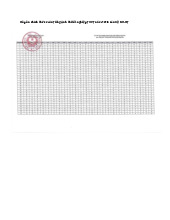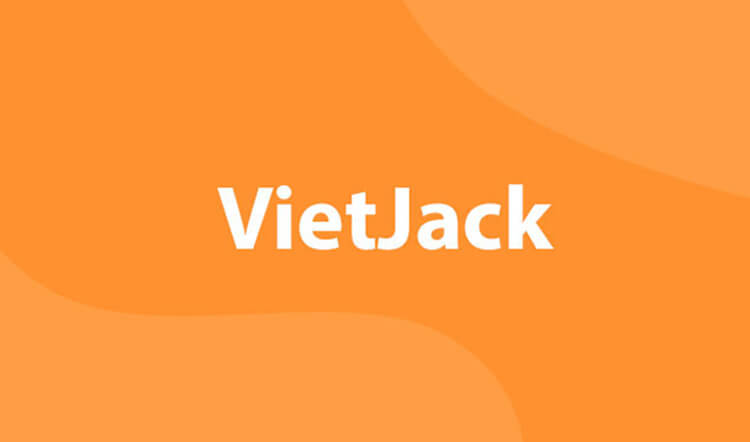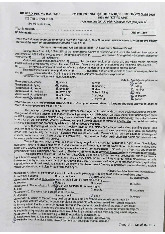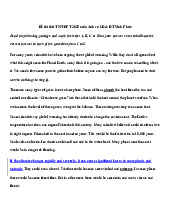















Preview text:
Đề thi thử tiếng Anh THPT Quốc gia 2025 có đáp án
Read the following advertisement and mark the letter A, B, C and D on your answer
sheet to indicate the option that best fits each of the numbered blanks from 1 to 6.
EMBARK ON YOUR ENTREPRENEURIAL JOURNEY WITH “SHARK TANK” TV SHOW
Have you ever dreamed of launching your own (1) _____ start-up but
struggled to take the first step? With “Shark Tank”, you can (2) _____ your
groundbreaking ideas to use and secure your spot in the competitive business world.
The key to start-up success lies in crafting a (3) _____, which includes setting
realistic goals and cultivating a positive mindset. By becoming a part of “Shark Tank”,
you’ll also learn to capitalize (4) _____ opportunities in niche markets. From refining
your pitch to attracting investors, our resources, (5) _____ to meet the needs of
aspiring entrepreneurs, will ensure your success.
Take the leap today and embrace this chance to thrive in a dynamic
environment that encourages (6) _____ towards creativity and excellence!
(Adapted from https://vtcnews.vn) 1. A. innovate B. innovative C. innovation D. innovatively 2. A. set B. get C. stand D. put
3. A. comprehensive strategy financial
B. financial comprehensive strategy
C. comprehensive financial strategy
D. financial strategy comprehensive 4. A. off B. with C. in D. on 5. A. customizing B. customized
C. which customize D. customizes 6. A. to gravitating B. to gravitate C. gravitating D. gravitate
Read the following leaflet and mark the letter A, B, C or D on your answer sheet to
indicate the option that best fits each of the numbered blanks from 7 to 12.
Save the Earth, One Step at a Time!
Let’s explore what we can do in our daily lives to help protect the environment. Key Facts: ●
Every year, over 8 million tonnes of plastic enter our oceans, threatening (7) _____ life and ecosystems. ●
Transport is a significant contributor to greenhouse gas emissions,
especially air travel, which can account for up to 10% of your yearly carbon footprint. What You Can Do:
Eat Sustainably: Choose a plant-based diet when possible. Reducing meat
and dairy consumption not only (8) _____ on greenhouse gas emissions (9) _____
also helps prevent deforestation for animal feed crops.
Reduce Waste: Avoid single-use plastics. Opt for reusable bags, containers,
and water bottles. Every time you (10) _____, you prevent more plastic waste from
ending up in landfills or oceans.
Travel Responsibly: Whenever possible, walk or bike short distances. If traveling longer distances,
(11) _____ public transport or trains instead
of flights to save a large (12) _____ of carbon emissions.
Adapted from WWF, Global Stewards 7. A. aquatic B. wildlife C. marine D. coastal 8. A.gets down B. cuts down
C.breaks up D. breaks down 9. A. and B. or C. so D. but 10. A. reuse B. recycle C. reduce D.refill 11. A. avoid B. consider C. ignore D. prefer 12. A. other B. many C. much D. amount
Mark the letter A, B, C or D on your answer sheet to indicate the best arrangement
of utterances or sentences to make a meaningful exchange or text in each of the
following questions from 13 to 17. 13.
a. Shop assistant: Certainly, but can you let me know about your needs first? b.Tim: I’m a student, so I’d like a cheap and light laptop.
c.Tim: I’m looking for a laptop. Could you please recommend something good to me?
(Adapted from Global Success) A. b – a – c B. c – a – b C. a – c – b D. b – c – a 14.
a. Minh: It was fantastic! The men played all my favorite songs.
b. Minh: Yes, I got to take a picture with Soobin after the show! c. Nam: That sounds like a memorable experience!
d. Nam: I heard the concert Anh Trai Vuot Ngan Chong Gai last night was amazing! How was it?
e. Nam: Did you get a chance to meet any of the 17 men?
A. d - b - a - e - c B. c - b - a - e - d
C. d - a - e - b - c D. c - d - e - b - a 15. Hi Alex,
a. I appreciate the recommendation for the language app-it’s been so helpful for my French practice.
b. Thanks for the podcast you suggested last week; it was really inspiring to listen to
successful language learners share their tips.
c. By the way, have you ever considered joining an online language exchange group?
I think it could be fun to try together.
d. I’ve been trying to set aside more time for speaking practice, but it’s a bit
challenging with my busy schedule.
e. Still, I’m motivated to improve my French, and I’ll let you know if I find other useful resources. Write back soon, Jordan
A. b – a – e – d – c B. b – a – d – c – e
C. a – e – c – d – b D. d – a – c – e – b 16.
a.Furthermore, highly educated women have opportunities to become leaders at work.
b.Secondly, educated women can both take care of their children and fulfil their job requirements.
c.In conclusion, there should be no sex discrimination in our society nowadays.
d.Their incomes are higher and higher. Why has the situation changed lately?
e. Firstly, girls who stay at school longer can build their good backgrounds.
f. The number of women who become highly educated labourers is increasing.
A. f – d – e – b – a – c
B. d – a – c – f – e – b
C. b – a – e – c – d – f
D. d – c – e – a – b – f 17.
a. The flexibility of this role allows me to meet with clients both in person and
virtually, adapting to their needs.
b. Over the past year, I have done this job at an environmental agency, helping clients
make greener choices for their homes and businesses.
c. Overall, I find great satisfaction in my work, as it aligns with my values and
empowers others to adopt sustainable practices.
d. Although some projects require travel to remote locations for assessments, these trips provide valuable insights into environmental challenges.
e. My enthusiasm for sustainable living and environmental advocacy inspired me to
pursue a career in eco-consulting.
A. e – a – d – b – c B. e – a – b – d – c C. e – b – a – d – c D. e – d – a – b – c
Read the following passage and mark the letter A, B, C or D on your answer sheet
to indicate the option that best fits each of the numbered blanks from 18 to 22.
Galileo Galilei, one of the first modem scientists, (18) _____. About twenty
years later, he attended the University of Pisa. At first, he studied philosophy, but
later he studied mathematics and astronomy. He was interested in the way the earth
and other planets move around the sun. He made the telescope (19) _____. He also
started a new way of working in science. Before Galileo, scientists did not do
experiments. They just guessed about how something happened. Galileo was different.
He did not just make guesses. (20) _____.
Galileo was famous for his study of how things fall. He was the first person to
do experiments about this problem. Before that, people thought that heavy things
always fell faster than light things. He found out that this was not true. He took a
heavy ball and a light ball, and he dropped them both from a high place. They fell at
the same speed. This meant that weight is not important. This is the law of falling bodies. (21) _____.
The life of the scientist was not always easy in the 1500 s. For example, having
incredible scientific ideas, (22) _____. His ideas were not the same as the religious
ideas at the time.Many religious people did not agree with him. During his whole life,
he had to worry about this. He even went to prison for a while. But no one could stop
him from thinking. He continued to look for scientific answers to his questions about the world.
18. A. being born in Pisa, Italy, in 1564
B. was born in Pisa, Italy, in 1564
C. gave birth in Pisa, Italy, in 1564
D. who was born in Pisa, Italy, in 1564
19. A. made the examination of far -away things larger and easier
B. tried to examine far-away things which look larger and easier
C. which made far-away things look larger and easier to examine
D. of which far-away things look larger and easier to examine
20. A. Other scientists helped him do experiments and watched to see what happened
B. Having watched to see what happened, he did experiments
C. He did experiments and watched to see what happened
D. Experiments he did contributed to what happened
21. A. We can understand our world without this important law
B. It is an important law for understanding our world
C. It is important to understand our world with an important law
D. To understand our world, it is an important law
22. A. these ideas made life difficult for Galileo
B. Galileo got into trouble
C. Galileo’s life became very hard
D. many troubles came to Galileo
Read the following passage and mark the letter A, B, C or D on your answer sheet
to indicate the best answer to each of the following questions from 23 to 30.
The preservation of natural resources is a critical challenge that requires
innovative solutions and technological advancements. As the global population grows
and the demand for resources accelerates, the need for smarter, more efficient
methods of conservation becomes paramount. Innovation in this field is not just
about creating new technologies but also about rethinking our approach to resource management.
Technological advances have the potential to revolutionize the way we use and
conserve natural resources.For instance, advancements in renewable energy
technologies, such as solar and wind power, are reducing our reliance on fossil fuels
and helping to decrease greenhouse gas emissions. Similarly, precision agriculture
uses data and technology to optimize crop yields and reduce waste, thereby
conserving water and soil quality.
Innovation also plays a role in monitoring and protecting ecosystems. Cutting-
edge tools like satellite imagery and drones provide valuable data on deforestation,
wildlife populations, and environmental changes. This information is crucial for
making informed decisions about conservation efforts and for tracking the
effectiveness of those efforts over time.
Water resources, essential for all life, are under increasing stress due to
pollution and overuse. Innovative water purification and desalination technologies are
expanding access to clean water, while smart irrigation systems ensure that crops
receive the right amount of water at the right time, minimizing waste.
The role of technology in resource conservation is not limited to large-scale
projects. On a smaller scale, apps and devices that monitor energy and water usage
can empower individuals to make more sustainable choices in their daily lives. These
user-friendly tools make it easier for people to understand their impact on the
environment and take steps to reduce it. (Adapted from
https://alewk.com/blog/sustainable-technology- innovations)
23. Which of the following is NOT mentioned as a technological advancement in resource conservation?
A. Renewable energy technologies B. Satellite imagery
C. Genetic modification of crops
D. Smart irrigation systems
24. The word paramount in paragraph 1 is OPPOSITE in meaning to _____. A.important B. trivial C.necessary D.crucial 25. The word optimize in paragraph 2 refers to _____. A.minimize B. maximize C.complicate D.disregard
26. The phrase under increasing stress in paragraph 4 could be best replaced by _____.
A.gaining more attention B.facing more pressure
C. receiving more support D.improving steadily
27. Which of the following best paraphrases the underlined sentence in paragraph 3? A. Monitoring ecosystems is not important. B. Advanced tools help in conservation efforts. C. Traditional methods are more effective for monitoring.
D. Data collection does not influence decisions.
28. Which of the following is TRUE according to the passage? A. Technology cannot improve resource conservation. B. Individual actions have no impact on conservation. C. Innovative solutions are essential for sustainability.
D. Renewable energy sources are harmful to the environment.
29. In which paragraph does the writer discuss the impact of technological tools on individuals? A. Paragraph 1 B. Paragraph 2 C. Paragraph 3 D. Paragraph 5
30. In which paragraph does the writer emphasize the importance of water resources? A. Paragraph 1 B. Paragraph 2 C. Paragraph 3 D. Paragraph 4
Read the following passage and mark the letter A, B, C or D on your answer sheet
to indicate the best answer to each of the following questions from 31 to 40.
Obesity is a complex health issue characterized by an excessive accumulation
of body fat, which poses significant risks to an individual’s physical and mental well-
being. It is generally measured using the Body Mass Index (BMI), where a BMI of 30
or higher indicates obesity. This condition is not merely a result of personal choice;
rather, it is influenced by a myriad of factors including genetics, environment, and
lifestyle choices. As the global prevalence of obesity continues to rise, it is crucial to
understand itsunderlying causes and far-reaching consequences.
Obesity is caused by a complex interplay of genetic factors and environmental
influences. For instance, individuals with a family history of obesity may possess
genes that affect how their bodies regulate hunger and metabolism. In addition to
genetic factors, the modern environment - characterized by the proliferation of fast
food outlets, sedentary lifestyles, and the pervasiveuse of technology - significantly
contributes to unhealthy weight gain. Furthermore, socio-economic factors play a
pivotal role, as low-income individuals may have limited access to nutritious foods
and safe spaces for physical activity.
[I] It is a leading risk factor for numerous chronic diseases, including type 2
diabetes, cardiovascular diseases, and certain types of cancer. [II] Additionally,
obesity can adversely impact mental health, leading to issues such as depression,
anxiety, and low self-esteem due to societal stigma. [Ш] The economic burden
associated with obesity is also substantial, with increased healthcare costs and lost
productivity posing significant challenges to both individuals and healthcare systems. [IV]
A holistic approach involving individuals, communities, and governments
is essential to address the obesity crisis. At the individual level, adopting healthier
dietary habits and increasing physical activity are essential steps for weight
management. On a community scale, creating supportive environments - such as safe
parks, accessible recreational facilities, and educational programs - can empower
individuals to make healthier choices. All in all, comprehensive policy measures,
including regulations on food marketing and subsidies for healthy foods, are
imperative to foster an environment conducive tomaintaining a healthy weight and improving public health outcomes.
Where in paragraph 3 does the following sentence best fit?
The health implications of obesity are profound and wide-ranging, affecting
nearly every system in the body. A. [I] B. [II] С. [Ш] D. [IV]
31. The phrase conducive toin paragraph 4 could be best replaced by _____. A. harmless to B. indifferent to C. detrimental to D. beneficial to
32. The word itsin paragraph 1 refers to _____.
A. personal choice B. environment C. global prevalence D. obesity
33. Which of the following is NOT mentioned as a cause of obesity in the passage? A. genetic factors B. medical conditions C. technology use D. fast food outlets
34. Which of the following best summarizes paragraph 2?
A.Obesity is solely caused by an individual’s lifestyle choices, such as diet and exercise.
B. Genetic factors alone are responsible for obesity, regardless of environmental conditions.
C. Obesity arises from a combination of genetic predispositions, environmental
factors, and socio-economic challenges.
D. Access to nutritious food and physical activity is the only determinant of obesity.
35. The word pervasivein paragraph 2 is OPPOSITE in meaning to _____. A. universal B. limited C. common D. irritating
36. Which of the following is TRUE according to the passage?
A.Comprehensive policy measures are unnecessary if individuals adopt healthier
dietary habits and increase physical activity.
B. The economic burden of obesity is minimal and has no significant impact on healthcare systems.
C. Creating supportive environments in communities is not considered an
effective strategy for combating obesity.
D. Those with a familial background of obesity could carry genetic
characteristics that impact their hunger levels and metabolic rates.
37. Which of the following best paraphrases the underlined sentence in paragraph 4?
A.To confront the obesity challenge, a united effort among individuals, local
communities, and governmental organizations is necessary.
B. Not until individuals, communities, and governments collaborate will the
obesity crisis be properly concealed.
C. Only by working separately can individuals, communities, and governments
effectively address the obesity crisis.
D. It is crucial to adopt a fragmented approach that focuses solely on personal
responsibility to tackle the obesity problem.
38. Which of the following can be inferred from the passage?
A.The global obesity crisis can be resolved through medical interventions alone.
B.Mental health issues related to obesity are less significant than the physical health risks.
C. Community efforts, such as providing safe parks and educational programs, can support healthier living.
D. Obesity primarily affects high-income individuals with access to fast food and technology.
39. Which of the following best summarizes the passage?
A. Obesity is a lifestyle issue caused by poor dietary choices and lack of exercise.
B. Obesity is a growing global health concern influenced by genetics,
environment, and socio-economic factors, with significant physical, mental, and economic consequences.
C. The economic burden of obesity is the most pressing concern, requiring government intervention.
D. Obesity can be addressed solely through individual efforts to adopt healthier habits. ĐÁP ÁN 1. B 11. D 21. B 31. A 2. D 12. D 22. B 32. D 3. C 13. B 23. C 33. D 4. D 14. C 24. B 34. B 5. B 15. B 25. B 35. C 6. C 16. A 26. B 36. B 7. C 17. C 27. B 37. D 8. B 18. B 28. C 38. A 9. D 19. C 29. D 39. C 10. A 20. C 30. D 40. B
Document Outline
- Đề thi thử tiếng Anh THPT Quốc gia 2025 có đáp án




